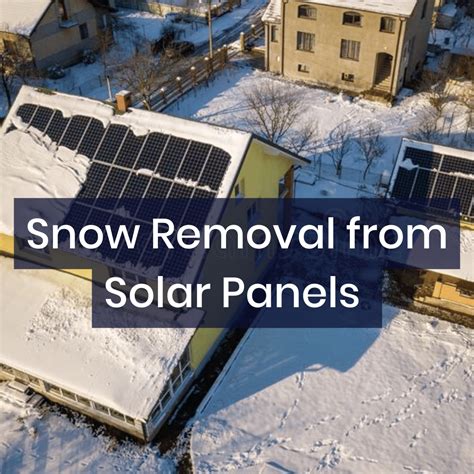Quick and Easy Solar Panel Snow Removal for Homeowners
Winter’s icy grip can significantly impact your solar panel system's efficiency. Snow accumulation reduces sunlight reaching the panels, leading to decreased energy production and potentially impacting your electricity bill. Fortunately, removing snow from your solar panels doesn't have to be a daunting task. This guide provides quick and easy methods for homeowners to safely and effectively clear snow from their solar panels, maximizing energy generation throughout the winter months.
Why is Snow Removal from Solar Panels Important?
Even a light dusting of snow can reduce your solar panel output by as much as 10%. Heavier snow accumulation can drastically decrease energy production, potentially leading to a significant loss in energy savings over the winter. Regular snow removal ensures your system continues to perform optimally and maximizes your return on investment.
How Much Snow is Too Much Snow on Solar Panels?
There's no magic number, as the impact of snow on solar panel efficiency depends on several factors, including the angle of your panels, the type of snow (wet or dry), and the intensity of sunlight. However, a good rule of thumb is to remove snow when it significantly obscures the panels, or after several inches have accumulated. If you notice a substantial drop in your energy production, it's time to clear the snow.
Safe and Effective Snow Removal Techniques: Methods to Avoid Damage
Avoid using harsh chemicals or abrasive tools that could damage the delicate surface of your solar panels. Here are some safe and effective methods:
1. The Gentle Brush-Off:
- Best for: Light to moderate snow accumulation.
- Tools: A soft-bristled broom or brush with a long handle (to reach the panels safely from the ground).
- Method: Gently brush the snow from the panels, starting from the top and working your way down. Avoid applying excessive pressure to prevent scratching the panel surface.
2. The Power of the Sun (Passive Snow Melt):
- Best for: Light snow accumulation on south-facing panels during sunny days.
- Tools: None required!
- Method: Let the sun do the work. On sunny days, the sun's heat can naturally melt the snow from your panels. This is the most convenient and safest method, provided the snow isn't too thick or heavy.
3. Snow Removal Tools for Higher-Angle Panels:
- Best for: Heavy snow accumulation or panels mounted at higher angles.
- Tools: A soft-bristled snow brush with an extendable handle, a leaf blower (use on low setting), or a specialized solar panel snow rake.
- Method: Use the extended reach tools cautiously. If using a leaf blower, start with low settings and keep a safe distance from the panels to avoid damaging them. A snow rake offers more controlled snow removal.
Important Note: Always exercise caution when working at heights. If your panels are on a roof, consider hiring a professional for snow removal, especially in heavy snow conditions.
What NOT to do when cleaning your solar panels
- Don't use hot water: Sudden temperature changes can damage the panels.
- Don't use harsh chemicals: These can degrade the panel's surface.
- Don't use pressure washers: The high pressure can cause damage to the panels and their seals.
- Don't use sharp or abrasive tools: These can scratch or damage the panel's surface.
When to Call a Professional
If you're uncomfortable cleaning your solar panels yourself, or if you have a large or complex system, it's best to contact a professional solar panel cleaning service. They have the experience and equipment to safely and efficiently remove snow without causing damage.
Maintaining Optimal Solar Panel Efficiency Throughout Winter
Regular snow removal is crucial for maximizing your solar panel's energy production throughout the winter. Combining preventative measures with these easy snow removal techniques will ensure your system continues to perform optimally, providing you with clean, renewable energy even during the coldest months. Remember safety first, and if in doubt, call a professional.

